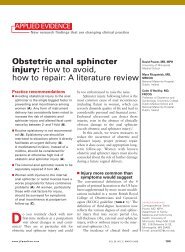Management of morbid obesity - The Journal of Family Practice
Management of morbid obesity - The Journal of Family Practice
Management of morbid obesity - The Journal of Family Practice
Create successful ePaper yourself
Turn your PDF publications into a flip-book with our unique Google optimized e-Paper software.
sitting may experience vomiting, especially during the<br />
early postoperative period. Other complications include<br />
the lodging <strong>of</strong> food particles or pills within the band or<br />
ring, and occasional band slippage or erosion. While<br />
<strong>morbid</strong>ity is low, weight loss also may tend to be less<br />
dramatic than with other forms <strong>of</strong> bariatric surgery.<br />
New procedures<br />
In the 1990s, procedures that do not rely on either malabsorption<br />
or restriction were introduced into bariatric<br />
surgery. Gastric and vagal pacing have been tested in<br />
animals and in preliminary human trials. 6 A hypothesis<br />
behind this approach is that induced gastric paresis<br />
and/or afferent vagal central nervous system stimulation<br />
will produce satiety and, as a consequence, weight loss.<br />
<strong>The</strong> electrical stimulation procedures are simple and<br />
easy to perform, but it is too early to determine their<br />
place in the armamentarium <strong>of</strong> bariatric surgery.<br />
Frequency <strong>of</strong> surgery by type<br />
Gastric bypass operations account for 65% <strong>of</strong> bariatric<br />
procedures performed worldwide, according to the<br />
IFSO survey. 1 <strong>The</strong> most common procedure in the<br />
world is laparoscopic Roux-en-Y gastric bypass (26%<br />
<strong>of</strong> all operations), followed by laparoscopic gastric<br />
banding (24%), open gastric bypass (23%), laparoscopic<br />
long-limb gastric bypass (9%), open long-limb gastric<br />
bypass (7%), vertical banded gastroplasty (5%), and<br />
biliopancreatic diversion/duodenal switch (5%).<br />
About 57% <strong>of</strong> bariatric procedures in the United<br />
States are performed laparoscopically, compared with<br />
63% worldwide. Similarly, gastric banding is performed<br />
less frequently than gastric bypass in the United States;<br />
it was not approved by the US Food and Drug<br />
Administration until the middle <strong>of</strong> 2001. About 20,000<br />
gastric bands were placed from 2001 to 2003 and<br />
another 40,000 were expected in 2004.<br />
Is there a clear winner?<br />
<strong>The</strong> heterogeneity <strong>of</strong> the bariatric surgery data makes it<br />
difficult to draw conclusions about the superiority <strong>of</strong> one<br />
procedure over another. Studies differ with regard to procedural<br />
variations, measures <strong>of</strong> weight change, and length<br />
<strong>of</strong> follow-up. Degree <strong>of</strong> weight loss must be balanced<br />
against operative risk, short- and long-term <strong>morbid</strong>ity,<br />
and the need for later revisional surgery. Moreover, while<br />
later <strong>morbid</strong>ity is heavily procedure-dependent, operative<br />
FIGURE 4<br />
Vertical banded<br />
gastroplasty<br />
Gastric banding<br />
THE JOURNAL OF<br />
FAMILY<br />
PRACTICE<br />
Restrictive procedures<br />
risk depends largely on the skill <strong>of</strong> the surgeon and may<br />
vary for patients undergoing the same operation.<br />
In the Cochrane review previously cited, 3 gastric<br />
bypass was associated with significantly greater weight<br />
loss and fewer revisions or conversions than gastroplasty,<br />
but also with more side effects and postoperative<br />
deaths. Greater weight loss, and fewer side effects and<br />
reoperations, occurred with adjustable gastric banding<br />
than with vertical banded gastroplasty. Weight loss was<br />
similar with open and laparoscopic procedures; however,<br />
the laparoscopic approach had fewer serious complications.<br />
Laparoscopic surgery was associated with<br />
March 2005 Supplement to <strong>The</strong> <strong>Journal</strong> <strong>of</strong> <strong>Family</strong> <strong>Practice</strong> 13









